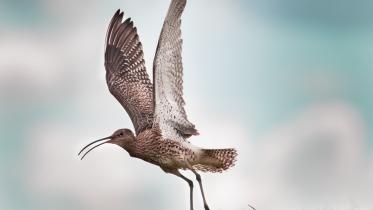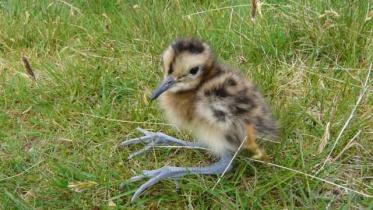Dealing with construction and birds
Published: 2016
-
Background
We are often asked by developers about how to deal with construction and birds, particularly for wind farms. To assist developers, we have published this note outlining the law and what it means for development, especially during the bird breeding season.
-
Legal protection for birds
The summary of legislation in this note is not comprehensive, and is intended for use as a guide only. It is ultimately the developer's responsibility to keep up to date with any changes to domestic legislation and comply with the law.
More detailed information about the level of protection for birds listed under each Schedule of the Wildlife & Countryside Act (including specific guidance about the law for birds on Schedules A1 & 1A, which are protected at any time of year) can be found on our website.
2.1 EU Birds Directive
The Birds Directive provides protection against deliberate disturbance of birds, particularly during the period of breeding and rearing (Article 5(d)). This refers specifically to disturbance levels that would affect delivery of the objectives of the Directive. This includes high levels of protection for species listed on Annex I of the Directive as well as certain general provisions for all naturally occurring birds in the wild[1]. To comply with the Directive, an assessment should be made to ascertain whether the disturbance would adversely affect the favourable conservation status of that species. We have published a methodology for “Assessing significance of impacts from onshore wind farms on birds outwith designated areas”.
2.2 Wildlife & Countryside Act 1981 (as amended in Scotland) (“W&CA”)
With the exception of birds listed in Schedule 2, and for certain specified purposes under licence, the W&CA makes it an offence to intentionally or recklessly:
- kill, injure or take a wild bird;
- take, damage, destroy or interfere with a nest of any wild bird whilst it is in use or being built (or at any time for a nest habitually used by any bird listed in Schedule A1);
- obstruct or prevent any wild bird from using its nest;
- take or destroy an egg of any wild bird;
- disturb any wild bird listed on Schedule 1 whilst it is building a nest or is in, on, or near a nest containing eggs or young, or whilst lekking;
- disturb the dependent young of any wild bird listed on Schedule 1.
Those birds listed on Schedules A1 and 1A receive additional protection which makes it an offence to intentionally or recklessly:
- at any time take, damage, destroy or interfere with any nest habitually used by any wild bird included in Schedule A1; and
- at any time harass any wild bird included in Schedule 1A.
In outline, to comply with the W&CA there should be no disturbance of breeding birds listed on Schedule 1, no interference with the nests of species listed on Schedule A1 at any time, nor disturbance/ harassment of birds listed in Schedule 1A at any time.
There should also be no direct physical interference with any wild birds, or their nests, whilst they are in use or being built or while they have dependent young. It is not, however, an offence to physically interfere with old nests - except for birds listed in Schedule A1.
2.3 What this means in relation to disturbance of breeding birds
Whilst it may not be illegal to disturb a species of breeding bird listed on Annex I of the Birds Directive that is not included on Schedule 1 of the W&CA, an assessment of the impact of disturbance will be required to demonstrate that this will not adversely affect the species' conservation status.
-
Disturbance distances
Different bird species have different tolerance levels to disturbance. Even within species, disturbance distances can vary according to time of year or geographical location. Some sensitive species may be disturbed by activity as much as 750m away.
It is therefore vital that consideration of disturbance distance is included in any Environmental Impact Assessment (EIA) / environmental appraisal, and used to inform site layout and construction phasing. To assist with this, we have published "A review of disturbance distances in selected bird species”.
-
Avoiding disturbance, including deterrence
Information on the general bird breeding season for a variety of species can be found via the ‘spreadsheet’ link on this webpage.
We encourage developers to programme construction outwith the breeding bird season, so as to reduce the risk of committing an offence. However, as the breeding season coincides with the best weather for construction, we recognise that this will not always be possible. In such situations, we recommend that a pre-construction breeding bird survey takes place, to inform how works can best be programmed to avoid disturbance. At some sites, surveys may also be required as construction progresses through the site (for example at large development sites where construction work will be phased by sectors). In either case, a watching brief should also be implemented during construction. In that way, if breeding birds are found, work in the affected area can be re-scheduled until after the young birds have successfully fledged (or breeding has failed), thus reducing the risk of committing an offence.
It may, however, be deemed necessary by the developer to continue construction work during the breeding season due to constraints across the construction project. To comply with the law, it would be necessary to deter birds from breeding on site before construction commences, to enable construction to take place without committing an offence. This is a risky approach as deterrence needs to be in place well before birds start looking for nest sites. In addition, it can never be guaranteed that any deterrence has been 100% successful. This means that an offence could still be committed if the method was not successful. Therefore we advise against relying on deterrence to allow construction works to take place during the bird breeding season, unless all other alternatives have been reasonably and justifiably discounted and the risk of committing an offence has been minimised through the use of pre-construction surveys and a watching brief.
For birds listed on Schedules A1 and 1A, please also refer to the relevant guidance.
-
Deterrence
We advise against relying on deterrence as it may not be successful. However, if developers wish to explore this as an option, we have the following advice:
If developers have explored all other options and wish to deter birds from nesting, then this must commence before nest building begins, well in advance of the likely start of egg laying. If nest building activity is seen, continued deterrence could be considered as disturbance and therefore an offence under the W&CA, so must be stopped immediately.
As each site will have different bird interests, land form and habitat characteristics, it is not possible to identify any single method of deterrence that might be effective at all sites. Examples known to NatureScot include employing people with dogs to walk through the site on a regular basis, use of bird scarers, reflective tape and/or ribbons on posts, or physical removal of habitat (e.g. removing turf from access tracks to deter birds breeding there). It should be noted that, as a general rule, we advise against physical removal or alteration of habitat. This is because there may be other direct and indirect adverse impacts on other environmental interests (e.g. non-avian species, important habitats, hydrology, etc.).
The impacts of any proposed deterrence methods must be assessed as part of the EIA/ environmental appraisal process. For example, an assessment should be made of the direct and indirect impacts of the proposed method(s) on the surrounding habitat, hydrology, protected species and any landscape and visual impacts, etc.
-
Key messages
- The majority of birds are protected through the W&CA from any activity or action that intentionally or recklessly obstructs or prevents a bird from using its nest. Schedule 1 birds are protected from any form of disturbance during the breeding season.
- The nests of birds listed on Schedule A1 of the W&CA are protected from any activity or action that intentionally or recklessly interferes with, damages or destroys their nest at any time.
- Birds listed in Schedule 1A of the W&CA are protected from harassment at any time.
- Many birds listed on Annex I of the EU Birds Directive are also listed on Schedule 1 of the W&CA (though there are notable exceptions such as golden plover and dunlin belonging to the sub-species schinzii). But because protected birds are also likely to be present where these species exceptions are found, we recommend that these exceptions are considered as having protection and mitigation applied accordingly. This will avoid inadvertently committing an offence by disturbing protected birds that may be nesting or roosting close by.
- Thorough survey work should be used to identify if legally protected birds are present and/ or likely to be affected by the proposed development during construction and operation.
- Developers should be aware that a valid planning consent does not over-ride the need to comply with the law in relation to species protection. Sufficient safeguards and mitigation must be put in place to ensure that construction does not result in an offence being committed under the W&CA.
-
Providing feedback on this guidance
We welcome constructive feedback on our guidance. If you have any suggestions on how to improve this guidance, or have any queries about it, please contact a member of the NatureScot Renewables Team.
Version 3, March 2016
[1] These include Articles 2, 3(1), 3(2)(b) and the last sentence of Article 4(4).





